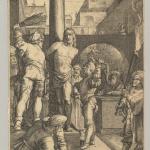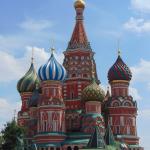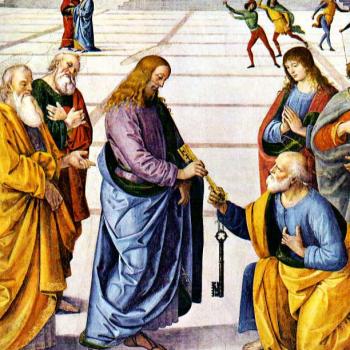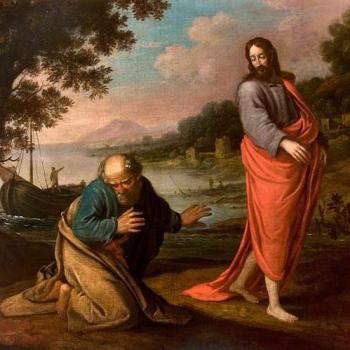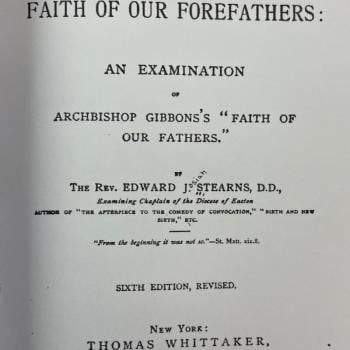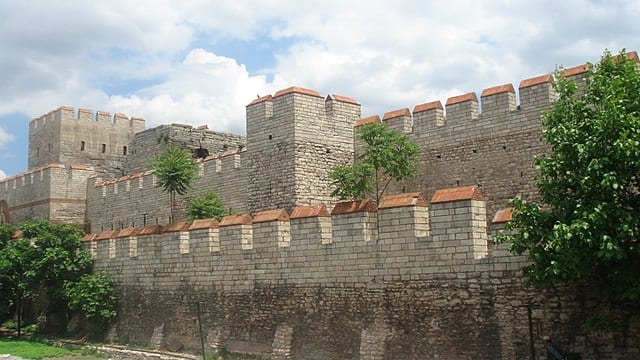
It was reported to me that someone (presumably Orthodox) caught wind of my chart of heretical Eastern Patriarchs (seen in this paper of mine, with my commentary). I will reproduce the chart below and then interact with his criticisms (his words in blue).
*****
A Chart of Heretical Eastern Patriarchs
-
-
- Antioch Paul of Samosata 260-269 Modalist
- Antioch Eulalius c. 322 Arian
- Antioch Euphronius c. 327-c. 329 Arian
- Constantinople Eusebius 341-42 Arian
- Constantinople Macedonius 342-60 Semi-Arian
- Antioch Leontius 344-58 Arian
- Alexandria George 357-61 Arian
- Antioch Eudoxius 358-60 Arian
- Constantinople Eudoxius 360 Arian
- Antioch Euzoius 361-78 Arian
- Constantinople Nestorius 428-31 Nestorian!
- Alexandria Dioscorus 448-51 Monophysite
- Alexandria Timothy Aelurus 457-60, 475-77 Monophysite
- Antioch Peter the Fuller 470, 475-7, 482-88 Monophysite
- Constantinople Acacius 471-89 Monophysite
- Antioch John Codonatus 477, 488 Monophysite
- Alexandria Peter Mongo 477-90 Monophysite
- Antioch Palladius 488-98 Monophysite
- Constantinople Phravitas 489-90 Monophysite
- Constantinople Euphemius 490-96 Monophysite
- Alexandria Athanasius II 490-96 Monophysite
- Alexandria John II 496-505 Monophysite
- Alexandria John III 505-518 Monophysite
- Constantinople Timothy I 511-17 Monophysite
- Antioch Severus 512-18 Monophysite
- Alexandria Timothy III 518-35 Monophysite
- Constantinople Anthimus 535-36 Monophysite
- Alexandria Theodosius 535-38 Monophysite
- Antioch Sergius c. 542-c. 557 Monophysite
- Antioch Paul “the Black” c. 557-578 Monophysite
- Alexandria Damianus 570-c. 605 Monophysite
- Antioch Peter Callinicum 578-91 Monophysite
- Constantinople Sergius 610-38 Monothelite
- Antioch Anthanasius c. 621-629 Monothelite
- Alexandria Cyrus c. 630-642 Monothelite
- Constantinople Pyrrhus 638-41 Monothelite
- Antioch Macedonius 640-c. 655 Monothelite
- Constantinople Paul II 641-52 Monothelite
- Constantinople Peter 652-64 Monothelite
- Antioch Macarius c. 655-681 Monothelite
- Constantinople John VI 711-15 Monothelite
-
First, I note you are not very scrupulous about citing what you lift verbatim, or even about checking its truth before posting it. You have
plagiarized this list and text from the site of well-known web-warrior and all-round hack, Dave Armstrong.
They are also factually incorrect. For a start, its Antiochene lineage immediately after Severus (Sergius c.542-c.557; Paul “the Black”
c.557-578; Peter Callinicum 578-91) is false. These were not Patriarchs of Antioch, but interlopers of the lineage of James Baradaeus
of Edessa. The recognized Patriarchs of Antioch of this time were:
Paul II 519-521 d. ?
Euphrasius 521-526
Ephraim 527-545
Domnus III 545-559
St. Anastasius I 559-570 d. 598
Gregory I 570-593
St. Anastasius I (restored) 593-598
You can confirm this list at the Antiochian Archdiocese Website. Your list does the same thing with the Alexandrian See, by including under the Chalcedonian succession Prelates of the Coptic succession (e.g. Damianos 570-c.605).
Secondly, the putative Armstrong’s (I am not sure he even wrote it and not one of his stooges) method of gauging the orthodoxy of the East “as represented by its three greatest bishops,” is plainly ridiculous, because it pays no attention to the internal dynamics between the bishops of the Eastern Church who were divided over how to interpret Nicea and Chalcedon. The two (Constantinople, Antioch) of the East’s “three greatest bishops” almost always fell prey to Imperial attempts at fostering unity with an Alexandria bent on rejecting the Nestorian tone of Chalcedon (particularly its Leonine contributions).
But this does not mean that all Antiochene or Constantinopolitan bishops succumbed to the view of the Patriarch the emperor had placed over them. They did not.
Of course. I never said that they did (which doesn’t take a rocket scientist to conclude). One must read my writing (and any writing) in context. I made it very clear what I was attempting to argue. For example, I stated:
Both East and West acknowledge wrongdoing in the tragic events leading up to 1054 when the schism finalized. Nevertheless, it is undeniably true that the West (and especially the Roman See) had a much more solid and consistent record of orthodoxy. For example, the Eastern Church split off from Rome and the Catholic Church on at least six occasions before 1054:
The Arian schisms (343-98)
The controversy over St. John Chrysostom (404-415)
The Acacian schism (484-519)
Concerning Monothelitism (640-681)
Concerning Iconoclasm (726-87 and 815-43)This adds up to 231 out of 500 years in schism (46% of the time)! In every case, Rome was on the right side of the debate in terms of what was later considered “orthodox” by both sides. Thus, the East clearly needed the West and the papacy and Rome in order to be ushered back to orthodoxy.
I was comparing the record of the Roman See, as exemplified by the pope, with the great Eastern Sees, as exemplified by the patriarchs. One can always find heresies and heretics amongst the laity; that was not what I was writing about. I was writing about the leadership. Thus, accordingly, I wrote:
All three of the great Eastern sees were under the jurisdiction of heretical patriarchs . . .
. . . the sees suffered under the yoke of a heterodox “shepherd” . . .
. . . sees burdened with sub-orthodox ecclesiastical leaders . . .
. . . the East, as represented by its three greatest bishops . . .
. . . the patriarchs of Constantinople, Alexandria, and Antioch were outside the Catholic orthodox faith . . .
No such scandal occurred in Rome, where, as we have seen, heresy was vigilantly attacked by the popes and local Synods, and never took hold of the papacy (not even in the ubiquitous “hard cases” of Honorius, Vigilius, and Liberius — none having defined heretical doctrines infallibly for the entire Church to believe). Rome never succumbed to heresy.
[all emphases added presently]
I was replying specifically to the anti-Catholic sorts of Orthodox who try to make out that Eastern Christianity is uniquely and exclusively apostolic, while denying that attribute to the West and Rome (they claim that Rome “fell away” from Orthodoxy, while they have kept it going).
Following this purpose, I carefully constructed a counter-argument (what this person conceives as the activities of a “web-warrior,” I guess), demonstrating the prevalence of heresy in the East, whereas it was always opposed at Rome, citing Newman’s famous comments on the Robber Council and the Henoticon, and presenting my “notorious” chart of heretical patriarchs. This is not an attack on Orthodoxy per se. Rather, it is a reply the anti-Catholic Orthodox (a minority position in Orthodoxy) denial of Catholic apostolicity.
A key phrase occurs in the citation by Cardinal Newman:
If the East could determine a matter of faith independently of the West, certainly the Monophysite heresy was established as Apostolic truth in all its provinces from Macedonia to Egypt . . . [my bolding]
Despite all this “internal evidence,” so to speak, critics such as this one, who can only view me as a “hack” because I have an honest and sincere disagreement with his position (while not at all denying his sincerity or Christian status), will be unable to see what I was doing, if they refuse to examine context and my purposes in the paper, which were repeatedly expressed quite clearly and openly.
Also, kindly note that Councils were not automatically considered Ecumenical in the Church’s consciousness straight off the bat, but by process and debate that culminated in their eventual confirmation by the next Council. This is how Robber Councils are weeded out. While in hindsight we might credit Rome with formally having stayed loyal to Nicea and Chalcedon, and condemn certain Eastern prelates with not having done so, this in many ways is a simplistic dichotomy. The fact is that the theological work and agitation that fermented in the East after these councils was formative to the reading applied to Nicea and Chalcedon by their immediately succeeding Councils and corrective of the modalist or Nestorian Roman readings of them that Easterners found so disturbing.
It depends on who is making the list of patriarchs, I reckon (somewhat like the controversies with three “popes” in the middle ages). The website, Syriac Orthodox Resources gives a different account, agreeing with mine.
Catholic Encyclopedia, “The Church of Antioch,” states:
In the latter part of the fifth century the Monophisites, under Peter Fullo, endeavoured to take possession of the patriarchal see. After the death of their leader Severus (539) they elected their own patriarchs of Antioch.
As an analogous example, the first site above cites the Arian succession of patriarchs of Antioch:
The Arians took control of the See of Antioch and appointed the following Patriarchs:
Eulalius 331-333
Euphornius 333-334
Philaclus 334-342
Stephanos 342-344
Leonce 344-357
Eudoxyos 358-359
Euzoios 360
But the Antiochian Orthodox Christian Archdiocese of North America gives the following list, which it calls the “Primates of the Apostolic See of Antioch (Orthodox Succession)”:
25 325 The Episcopacy of Eustathius in Antioch.
26 332 The Episcopacy of Paulinus in Antioch.
27 332 The Episcopacy of Eulalius (5 months) in Antioch.
28 333 The Episcopacy of Euphronius in Antioch.
29 334 The Episcopacy of Placentius in Antioch.
30 341 The Episcopacy of Stephanus in Antioch.
31 345 The Episcopacy of Leontius in Antioch.
32 350 The Episcopacy of Eudoxius in Antioch.
33 354 The Episcopacy of Meletius in Antioch.
34 354 The Episcopacy of Eudoxius in Antioch.
35 357 The Episcopacy of Annias (a.k.a. Ammianus) in Antioch.
36 360 The Episcopacy of Eudozius in Antioch.
37 370 The Episcopacy of Dorotheus in Antioch.
The first site appears to be a Monophysite group, but it calls itself “Orthodox” (Catholics understand that problem; we are plagued by heterodox who call themselves “Catholic” too). The second is, presumably, “Orthodox” by today’s standards of the major “orthodox” groupings of Orthodoxy, yet in its list it doesn’t appear to recognize that many of what it calls the “orthodox” patriarchs were, in fact, Arian (!!). Beyond that, the two lists contradict (not greatly, but somewhat, so that there is a question of actual succession).
How is an outsider to know which to choose, who is orthodox, and who were the actual patriarchs? The Monophysites claim that they had control of the see in the latter 6th century; the Orthodox simply revise the list and put in Chalcedonian patriarchs (who might have been in exile, underground, or in prison, for all we know). It is a matter of definition, of who holds an office, and what that means. One could define it politically, in terms of actual “political” power, or theologically (the leading and most influential orthodox local figure). This is an (altogether typical) Orthodox internal fight, not mine.
Melkite Greek Catholic Church Information Center agrees with the second list above, but again, makes no mention that seven or so patriarchs in a row in Antioch were Arian. We are informed, however, that:
Melkite Church tradition maintains that the See of Antioch was founded by The Holy, Glorious and Illustrious Prince of the Apostles Peter in 45. Then, The Holy, Glorious and Illustrious Prince of the Apostles Peter was the first Patriarch of Antioch. The first successor to Holy, Glorious and Illustrious Prince of the Apostles Peter was Euodius. After seven years in 53, The Holy, Glorious and Illustrious Prince of the Apostles Peter appointed Euodiusto succeed him as bishop of Antioch when Holy, Glorious and Illustrious Prince of the Apostles Peter began his trip to Rome. Then, Euodius was the second Patriarch of Antioch.
The second successor to Holy, Glorious and Illustrious Prince of the Apostles Peter was Holy Hieromartyr Ignatius the God-Bearer (St. Ignatius, Bishop of Antioch). In 68, he may have been appointed by and or consecrated by The Holy, Glorious and Illustrious Prince of the Apostles Peter or the Holy, Glorious and Illustrious Prince of the Apostles Paul. Then, Holy Hieromartyr Ignatius the God-Bearer was the third Patriarch of Antioch.
And so it gives the entire listing with no mention whatsoever of the Arian domination of the patriarchate in the fourth century.
Byzantine Studies Page gives the following list, which at least presents the fact that rival claimants existed, and mentions some heretics. Note that in 375, two or three rival patriarchs claimed the episcopacy, thus reflecting the situation of the Catholic Great Schism, of which much is always made by critics of the Catholic Church (and this, too, is claimed to be a Petrine succession):
324 or 325 – 330 Eustathios
330 [six months] Paulinos II
331-332 Eulalios
332-333 Euphronios
333-342? Flakillos
342-344 Stephen I
344-358 Leontios
358-359 Eudoxios
359 Annanios
360-381 Meletios
360-376 Euzoïos [Arian]
362-388 Paulinos II [Catholic]
375? Vital [Apollinarist]
376-381? Dorotheos [Arian]
I’m supposed to figure all this out, and then get accused of being a “hack” and (by strong implication) intellectually dishonest and incompetent as an apologist because I (gasp!) chose one list over another, when such confusion is manifest?
The same site lists rival “Jacobite Patriarchs” as opposed to “Melkite”:
557/558-about 561 Sergios of Teila
564-577 Paul the Black
581-591 Peter of Kallinikos
The Catholic Encyclopedia (“Patriarch and Patriarchate”) perhaps can alleviate some of this confusion:
At the time of Cerularius’s schism (1054) the great Church of the empire knew practically these five patriarchs only, though “minor” patriarchates had already begun in the West. The Eighth General Council (Constantinople IV, in 869) had solemnly affirmed their position (can. xxi). The schism, and further distinctions that would not have existed but for it, considerably augmented the number of bishops who claimed the title.
But before the great schism the earlier Nestorian and Monophysite separations had resulted in the existence of various heretical patriarchs. To be under a patriarch had come to be the normal, apparently necessary, condition for any Church. So it was natural that these heretics when they broke from the Catholic patriarchs should sooner or later set up rivals of their own. But in most cases they have been neither consistent nor logical. Instead of being merely an honourable title for the occupants of the five chief sees, the name patriarch was looked upon as denoting a rank of its own.
So there was the idea that one might be patriarch of any place. We shall understand the confusion of this idea if we imagine some sect setting up a Pope of London or New York in opposition to the Pope of Rome. The Nestorians broke away from Antioch in the fifth century. They then called their catholicus (originally a vicar of the Antiochene pontiff), patriarch; though he has never claimed to be Patriarch of Antioch, which alone would have given a reason for his title. Babæus (Bab-Hai, 498-503) is said to be the first who usurped the title, as Patriarch of Seleucia and Ctesiphon (Assemani, “Bibl. Orient.”, III, 427). The Copts and Jacobites have been more consistent.
During the long Monophysite quarrels (fifth to seventh cent.) there were continually rival or alternate Catholic and Monophysite patriarchs of Alexandria and Antioch. Eventually, since the Moslem conquest of Egypt and Syria, rival lines were formed. So there is a line of Coptic patriarchs of Alexandria and of Jacobite patriarchs of Antioch as rivals to the Melchite ones. But in this case each claims to represent the old line and refuses to recognize its rivals, which is a possible position.
As a representative example of one of the individuals under dispute, I cite:
A Dictionary of Christian Biography and Literature to the End of the Sixth Century A.D., with an Account of the Principal Sects and Heresies, edited by Henry Wace, D.D. & William C, Piercy, M.A., Hendrickson Publishers, Inc. edition / ISBN: 1-56563-460-8 / reprinted from the edition originally published by John Murray, London, 1911.
Entry for “Paulus the Black”:
Paulus (11), surnamed The Black, Jacobite patriarch of Antioch from about the middle of 6th cent. to 578, was a native of Alexandria (Assem. B. O. ii. 331) and, like most Egyptians, a Monophysite. Before he became bishop he maintained at Constantinople a successful public dispute in the patriarchal palace with the Tritheites Conon and Eugenius (ib. 329). Either Mennas or Eutychius must then have been patriarch. Paul was probably then syncellus to Theodosius, the Jacobite patriarch of Alexandria, who was in nominal exile at Constantinople, but exercising full authority over the Jacobite congregations there and in Egypt. Paul’s connexion with Theodosius, and his success as a disputant, marked him out for the titular see of Antioch and the patriarchate of the whole Monophysite body, then beginning to be called Jacobites, and he was consecrated by Jacob Baradaeus himself who originated the name. We cannot feel sure that this was before 550. Paul appears in a list of celebrities flourishing in 571 . . . In 578 a new patriarch of Antioch, Peter of Callinicus, was appointed, and Paul withdrew into concealment at Constantinople, where he died in 582, as detailed by John of Ephesus.
This is sufficient to answer the charge. There were rival claimants. I cited the line of succession known as the “Jacobites.” At the time I wrote the original piece (between 1991 and 1994) I wasn’t aware of the two simultaneous lines (one wouldn’t know about it by looking over most “lists” — excepting the one on the Byzantine Studies Page); now I am. It was an honest and understandable mistake (to the extent that I was mistaken at all — I’m not convinced).
Now that I have found additional clarifying information, I have promptly added it to my website, and I have reproduced the comments of my critic. I dare say that is more “honest” and “ethical” than the way I was treated by him (called an “all-round hack,” etc.).
***
Related Reading
Sack of Constantinople (1204) & Unknown Byzantine Atrocities [1998]
Anti-Catholic Orthodox Claims of Exclusive Apostolic Succession [Nov. 1998; revised in 2004]
Caesaropapism in Orthodoxy & the Byzantine Empire [2000]
***


